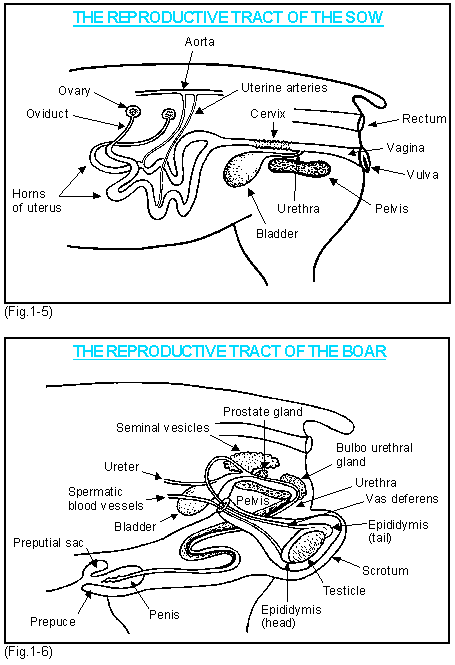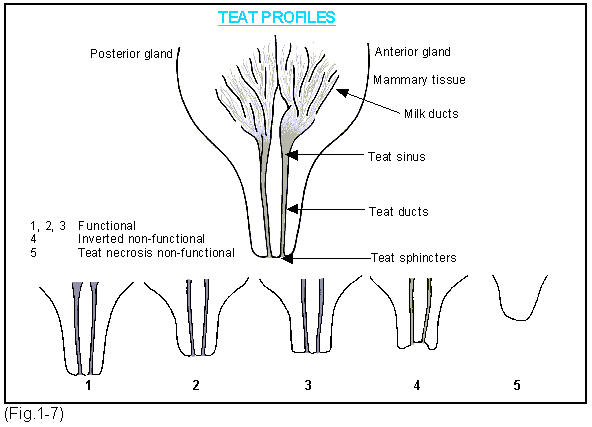



Reproductive system
Fig.1-5 and Fig.1-6 show the anatomy of the reproductive tracts of the sow and the boar.

Terminology
Abortion - The production of a premature non-viable litter, 111 days or less after mating.
Agalactia - Failure of milk let down or shortage of milk or no milk. The udder may be congested with or without mastitis. In certain conditions, such as mild ergot poisoning, mammary glands fail to develop.
Cervix - The neck of the womb. Inflammation of the cervix is called cervicitis. Cervicitis is not common in the pig, but erosion of the thick folds occurs in old sows and can cause infertility.
Conception rate - As a % this is calculated by:
No. of females which conceived x 100
No. of females mated or inseminated
The calculation is based on a given period of time. Often pig farmers calculate this over the same period of time for both. The top and bottom numbers should be calculated over equivalent periods of time so that the same sows are being counted.
The number conceived can be assessed by the number that did not return to heat or by the numbers judged to be pregnant at the first pregnancy test. Note that the conception rate is generally higher than the farrowing rate because of later embryo / foetus loss. Rolling one month, three month and six month averages of conception rates give an early indication of any developing infertility problems.
Conceptus - Fertilised ovum and embryo.
Corpora haemorrhagica - When the follicle ruptures to release the egg there is a small amount of haemorrhage. This is the name given to the bloody tissues that remain.
Corpus albucans - After pregnancy or after the animal has been in oestrus the corpus luteum disappears and shrinks to a small white body called the corpus albucans.
Corpus luteum - The corpora haemorrhagica becomes consolidated and forms the corpus luteum. This is the body that produces progesterone, the female hormone that maintains pregnancy.
Cryptorchid - A male pig whose testes have not descended through the inguinal canals. Normally, the testes develop in the abdomen and descend through the inguinal canal to the scrotum before birth. Sperm production in the testes require a cooler environment than that of the abdomen.
Embryo - The multicellular organism that develops in the uterus from the fertilised egg up to about 20-30 days when it becomes a foetus.
Endometritis - Inflammation and infection of the lining of the womb (the endometrium).
Epididymis - A coiled tube attached to the upper surface of the testicle where the sperm is stored. The sperm leaving it enters the vas deferens. It has a head and a tail. The tail can be cut off (epidectomy) to sterilise the boar. (See chapter 15).
Erythema - Reddening of the skin that is often seen when one or more mammary glands have mastitis.
Farrowing rate (%) This equals
No. females farrowed x 100
No. females mated
Female - Breeding female including gilts and sows. A gilt becomes a breeding female either from an arbitrary time before mating (e.g. when first brought into the mating area) or, more commonly, when she is first mated. Some pig farmers only include her from the time she farrows but this results in high and less useful indications of herd fertility when farrowing rates and numbers of pigs per female per year are calculated.
N.B. Many people use the term pigs per sow per year but this must include gilts.
Fertilised ovum - The egg as it multiplies and grows to approximately day seven post fertilisation.
Foetus - This describes the developing piglet from approximately 30 days through to maturity.
Inguinal canal - Gap between the muscles of the abdomen in the groin through which the spermatic cord passes from the abdomen to the testicle.
Implantation - The attachment of the embryo to the uterine wall by establishment of the placenta commencing 12 to 14 days post-mating.
Inverted nipples - These are shown in Fig.1-7. If the teat sphincter cannot be seen at eye level it is likely that such a teat will remain inverted and will not be functional. This is important to appreciate when selecting or receiving a gilt for breeding. Some inverted nipples will become more normal and be functional when the mammary gland develops but when selecting you cannot take the chance.
Note that each teat has two orifices and teat ducts which drain two quite separate mammary glands, front (anterior) and back (posterior).

Irregular return - A return to oestrus more than 23 days after the previous one.
Lactation length - The period from farrowing to weaning in days.
Litters/per female/per year is calculated by:
No. of farrowings over 3 months x 4
Average No. breeding females in the herd
In large herds this can also be calculated on rolling one month, three month and six month averages which gives a historical indication of rising or falling fertility. Thus for a three month average:
Average No. females in the herd over last 3 months x 4
Number of farrowings over last 3 months
Mammary oedema - Mammary tissues may contain excess amounts of fluid at farrowing. This fluid can either be under the skin when it can be easily seen and palpated, or deep in the actual tissue itself. Both these conditions can lead to agalactia, mastitis and poor availability of colostrum.
Mammary system - The udder of the sow consists of two parallel rows of 5 to 7 teats inter-spaced on each side.
Mastitis - Inflammation of the mammary gland is invariably associated with infection. Bacteria causing it include klebsiella, streptococci, staphylococci and E. coli.
Mastitis metritis agalactia syndrome (MMA) - This syndrome is most commonly associated with mastitis usually coliform mastitis i.e. caused by E. coli or klebsiella but it is also associated with endometritis. The sow is usually sick, running a high temperature and producing little milk. Other terms are sometime used for this syndrome including periparturient hypogalactia syndrome, puerperal toxaemia, and farrowing fever.
Mating - The complete act of copulation involving one or more services.
Mummified pigs - Piglets which died in the uterus and in which the tissues and fluids have been reabsorbed leaving black shrunken skeletal remains.
Non productive days (NPD) - These include all the days when the sows and gilts are either not pregnant or suckling. It therefore always includes:
- Entry of the gilt into the herd to point of mating.
- Time from weaning to mating.
- Time from mating to remating if the female is found not to be pregnant and returns to heat.
- Time after a female has been culled until the time it is slaughtered.
- NPD is a useful calculation because if it lengthens it may indicate a number of serious problems, including increases in the fail-to-farrow females (not in pig at term - NIP), females dying during pregnancy, and gilts with delayed puberty.
Oestrus (or heat) - The period during which the sow is receptive to the boar (i.e. will stand to be mated). Usually 1-3 days.
Oestrus cycle - The period from one oestrus to another. 19-22 days interval is normal.
Orchitis - Inflammation of the testicle. A specific example is infection by Brucella suis bacteria. Non infectious orchitis can arise from trauma to one or both testicles. Occasionally there may be a haemorrhage developing into a haematoma (a pocket of blood).
Ovaries - Two small structures which control the oestrus cycle and from which the follicles are produced and the eggs released.
Oxytocin - A hormone produced by the anterior pituitary gland. Its function is to release milk from the glands and at the same time cause the uterus to contract.
Parity - Used to describe the number of times a female has farrowed. e.g.Pregnant gilt = Parity 0; Gilt farrowed for the first time = Parity 1; Sow which has had two litters = Parity 2
(NB. Some people get confused and use the term parity when they mean pregnancy).
Pigs weaned per sow per year - The number of pigs produced in any 12 month period. In a large herd this is usually calculated as a one month, three month and six month rolling average of the whole herd.
Prepucial sac - This is a sac inside the prepuce, the size of a golf ball, that contains a foul smelling fluid with a high bacterial content. Do not squeeze its contents into the vagina at service or you may precipitate an endometritis or cystitis and nephritis. Similarly if you are collecting semen by gloved hand for on-farm artificial insemination you must not contaminate it with prepucial sac contents.
Prolactin - A hormone from the pituitary gland involved in the initiation and maintenance of milk production.
Pyometra - Accumulation of pus in the womb following infection. It is also called pyometritis. This is common when heavy vulva discharges are seen or a retained foetus or placenta are present.
Regular return - A return to oestrus usually 19-22 days after previous one.
Salpingitis - Inflammation of the oviducts (fallopian tubes) that carry the eggs from the ovary down towards the womb.
Scrotum - This is a sack made of relatively thin pliable skin which has a muscular inner fibro-elastic layer which contracts in a cold environment and relaxes in a hot environment.
Seminal vesicles - These are glands which together with the prostate and bulbo-urethral glands provide fluid and nourishment for the sperm, the fluids being passed out during ejaculation.
Spermatic cord - Fibrous cord, containing the vas deferens and blood vessels, by which the testicles are suspended.
Stillborn pigs - Piglets observed dead behind the sow at birth.
Teat necrosis - Damage to the end of the teat can result in death and sloughing of tissues. This is called necrosis. It is caused by abrasive floor surfaces in the first 18-24 hours of birth and can be an important reason for rejecting gilts for breeding.
Testicle - The gland in which the sperm is produced.
Urethritis - inflammation of the urethra, the tube which carries both sperm and urine down the penis in the boar or urine from the bladder to the vagina in the sow. Urethritis is uncommon in the boar but can occasionally be caused by small calculi or stones formed in the kidneys. The urethra of the sow is much more likely to become contaminated and infected because its opening is so close to the vulva. Urethritis and cystitis are therefore common in the sow.
Uterus (womb) - Consists of two horns upto 1.5m in length that contain the foetuses.
Vagina - The passageway from the exterior to the cervix. Vaginitis (inflammation) occurs following trauma, infection or multiple matings.
Vas deferens - The muscular tube that at ejaculation propels the sperm from the tail of the epididymis on the testes up through the inguinal canal and into the urethra where it joins just below the neck of the bladder . Vasectomising a boar involves cutting the vas deferens midway between the tail of the epididymis and its entry to the abdomen, removing 30-50mm of it. (See cptr 15).
Vulva - The vagina opens to the exterior through the fleshy lips of the vulva. Oedema of the vulva (swelling containing fluid) occurs in late pregnancy and trauma is very common in loose-housed sows. The tissues contain many blood vessels and are prone to haemorrhage. Haemorrhage (haematoma) is also seen in the gilt post farrowing. Such animals can bleed to death. (See chapter 15).Previous Page Pig Health Index Next Page





